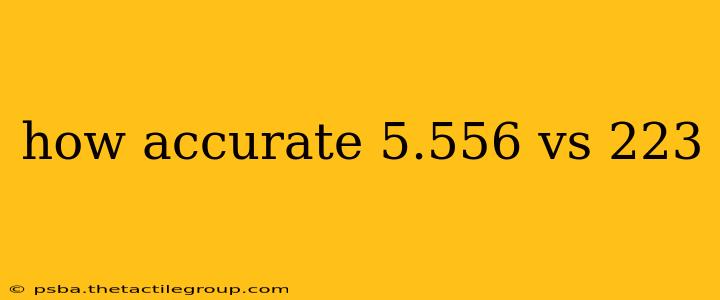5.56 vs .223: A Deep Dive into Cartridge Accuracy
The question of 5.56 NATO vs .223 Remington accuracy is a complex one, often debated among shooters and firearms enthusiasts. While both cartridges use the same projectile diameter (.224 inches), subtle differences in chamber dimensions, pressure specifications, and ammunition manufacturing lead to variations in accuracy. There's no single definitive answer to which is "more accurate," as accuracy depends on a multitude of factors beyond just the cartridge itself.
Understanding the Differences: Chamber Specificity
The key difference lies in chamber specifications. The .223 Remington chamber is smaller and tighter than the 5.56x45mm NATO chamber. This difference has significant implications:
-
Pressure: 5.56 NATO cartridges are designed to operate at higher pressures than .223 Remington rounds. Firing 5.56 ammunition in a .223 chamber can result in dangerously high pressures, potentially causing damage to the firearm. Conversely, while less risky, firing .223 in a 5.56 chamber can lead to inconsistent accuracy due to the looser fit.
-
Accuracy Impact: This pressure difference and chamber dimension variance can affect accuracy. In a rifle chambered specifically for .223, the tighter fit can lead to better bullet stability and potentially enhanced accuracy, particularly at longer ranges. However, this is not always guaranteed and depends heavily on the ammunition's quality and the rifle's barrel. A 5.56mm chambered rifle, intended for higher pressure rounds, might be less accurate with .223 ammunition due to potential bullet movement and instability.
Factors Beyond Cartridge Type Affecting Accuracy
Numerous factors beyond the cartridge itself play a crucial role in overall accuracy:
-
Rifle Quality: The quality of the rifle barrel, action, and stock significantly impacts accuracy. A high-quality barrel with a superior rifling profile will produce better results regardless of whether it’s firing .223 or 5.56 ammunition.
-
Ammunition Quality: The consistency and quality of the ammunition are paramount. Higher-quality ammunition with consistent bullet weights, powder charges, and construction will naturally lead to tighter groupings.
-
Shooter Skill: The skill and technique of the shooter are perhaps the most important variables affecting accuracy. Even the best ammunition and rifle will produce poor results with poor shooting technique.
-
Environmental Conditions: Wind, temperature, and humidity can all influence bullet trajectory and accuracy.
-
Barrel Length: Longer barrels generally improve accuracy due to increased bullet velocity and stabilization.
Practical Implications and Conclusion
So, which is more accurate? The reality is that both cartridges are capable of high accuracy in the right conditions. A high-quality rifle chambered for .223 might offer a slight edge in accuracy with properly-matched ammunition, due to the tighter chamber tolerances. However, the difference might be negligible for many shooters, especially at shorter ranges.
Ultimately, the choice between .223 and 5.56 should be driven by the intended application and the specific firearm being used. If you prioritize maximum accuracy with precision shooting in mind, a .223 Remington chambered rifle with high-quality ammunition is often preferred. For applications where the higher-pressure 5.56 NATO round is necessary, such as military use, the potential slight reduction in accuracy might be an acceptable trade-off. Always consult your firearm's manufacturer's guidelines regarding ammunition compatibility to ensure safe and reliable operation.

